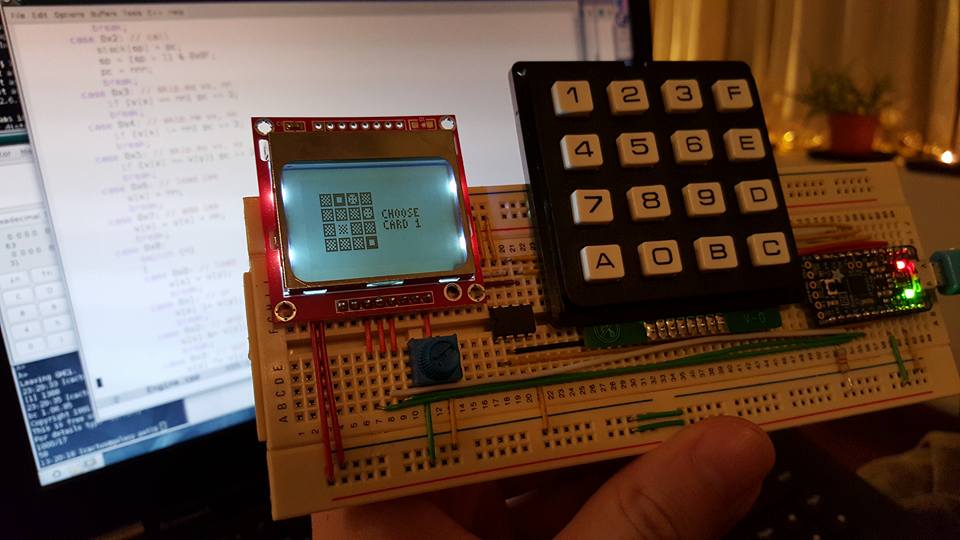CHIP-8 implementation for a very simple breadboard toy
This is a CHIP-8 virtual machine implementation running on AVR.
Its big party trick is that it is written in Rust: it is the first non-trivial Rust application running on AVR. You can read about its development process in my blog post. The CHIP-8 VM itself is implemented in a separate, portable crate written in idiomatic Rust fashion, heavily using algebraic data types and pattern matching; this crate can then be used both to build an SDL-based desktop app and also this crate running on AVR microcontrollers.
The intended hardware is a simple circuit with very few components:
- AVR ATMega328P microcontroller
- PCD8522 84x48 monochrome LCD
- Microchip 23K640 serial RAM
- 4x4 keypad
- 10K resistors (4 pcs)
- 10K trimpot
All of these components come in throughhole versions so it is very easy to build it on a breadboard. NOTE THE RAM CHIP DOESN'T SUPPORT 5 Volts. The board is meant to be powered at 3.3 Volts. An Arduino Uno is going to fry the RAM chip.
Building
AVR support in Rust is not yet available its mainline version, and there are some questionable hacks that I had to add to work around some compiler bugs and missing features. All this means you'll need to build very specific versions of LLVM and Rust to be able to compile this crate. Also, because of some remaining bugs in the LLVM AVR backend, Rust's stock libcore cannot be compiled yet; we need to use Xargo to link to a slightly stripped down version.
1. Build branch of LLVM with AVR support + kludges
$ git clone -b avr-rust-demo https://github.com/avr-rust/llvm.git llvm-avr
$ mkdir -p build/llvm
$ cd build/llvm
$ cmake ../../llvm-avr -DLLVM_EXPERIMENTAL_TARGETS_TO_BUILD=AVR -DLLVM_TARGETS_TO_BUILD=X86
$ make
$ cd ../...
2. Build branch of rustc with AVR support
$ git clone -b avr-support https://github.com/avr-rust/rust.git rust-avr
$ mkdir -p build/rust
$ cd build/rust
$ ../../rust-avr/configure --llvm-root=$(realpath ../llvm)
$ make
$ cd ../..
3. Register freshly-built Rust AVR toolchain with rustup (needed to work around a Xargo bug)
$ rustup toolchain link avr-toolchain $(realpath build/rust/build/x86_64-unknown-linux-gnu/stage1
$ rustup default avr-toolchain
4. Build chip8-avr and all its dependencies using Xargo
$ git clone https://github.com/gergoerdi/rust-avr-chip8-avr chip8-avr
$ cd chip8-avr
$ sh build.sh
Running
The above process will result in the AVR ELF executable target/avr-atmega328p/release/chip8-avr.elf. This executable can be uploaded to the ATMega328P via an AVR programmer; or if you use something like an Arduino Pro 3.3V or an Adafruit Trinket Pro 3.3V, you can upload it directly via USB.
Another way of trying it out is simulation: I've implemented a SimAVR-based simulator for the above schematics that almost runs in real time, as an interactive SDL app.
What's next?
There is no shortage of Rust and LLVM bugs and missing features in the AVR backends, if you want to help out.



